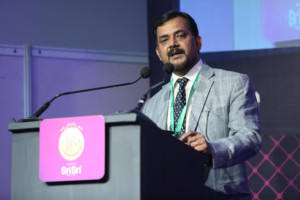Food Safety Conclave was organized at the India Food Forum 2017 on February 02, 2017. The conclave was represented by high profile officials from the Central Government and Industry to discuss current trends, recent regulations, best practices and challenges related to Food Safety.
 The Food Safety Conclave was moderated by Shalini Chakravorty, Vice President – Ethics & Compliance – Asia, Walmart. As a background to the conclave, it’s imperative to talk about Food Safety as the consumer today is increasingly becoming more aware and wants to take informed decisions. Consumer’s food value equation is gradually changing from price, taste and convenience to health, wellness, safety, social impact and experience. Wellness and safety are definitely influencing the consumer behaviour and consumers are increasingly looking for information such as food safety standards, complete and accurate labelling and traceability etc. Looking at these changes, the responsibility of providing safe food to the consumers assumes critical importance and needs to be shared equally at every stage of the value chain starting from food production.
The Food Safety Conclave was moderated by Shalini Chakravorty, Vice President – Ethics & Compliance – Asia, Walmart. As a background to the conclave, it’s imperative to talk about Food Safety as the consumer today is increasingly becoming more aware and wants to take informed decisions. Consumer’s food value equation is gradually changing from price, taste and convenience to health, wellness, safety, social impact and experience. Wellness and safety are definitely influencing the consumer behaviour and consumers are increasingly looking for information such as food safety standards, complete and accurate labelling and traceability etc. Looking at these changes, the responsibility of providing safe food to the consumers assumes critical importance and needs to be shared equally at every stage of the value chain starting from food production.
In fact not surprisingly the food industry – including growers, processors, retailers, distributors, foodservice operators – have become conscious about their products and offerings. Since most consumers receive their food from retail and food service establishments, a significant share of the responsibility for providing safe food to the consumer rests with them. Close collaboration among the regulatory authorities, retail operators and foodservice establishments can make a great impact on food safety aspects.
Some facts below from WHO Food safety factsheet also reiterate the importance of food safety:
– Unsafe food containing harmful bacteria, viruses, parasites or chemical substances, causes more than 200 diseases – ranging from diarrhea to cancer.
– An estimated 600 million – almost 1 in 10 people in the world – fall ill after eating contaminated food and 420,000 die every year, resulting in the loss of 33 million healthy life years (DALYs).
– Food-borne diseases impede socio-economic development by straining healthcare systems, and harming national economies, tourism and trade.
 Conclave Chairperson Dr. R P Singh, Secretary General, Quality Council of India (QCI) started the session by saying food affects quality of life, which impacts employment, exports and contribution to GDP. It is the joint responsibility of government and industry to protect consumers and provide best quality food.
Conclave Chairperson Dr. R P Singh, Secretary General, Quality Council of India (QCI) started the session by saying food affects quality of life, which impacts employment, exports and contribution to GDP. It is the joint responsibility of government and industry to protect consumers and provide best quality food.
For the Indian food industry to excel, providing good quality, innovation and safety is imperative in transforming it to a ‘Global Brand’. The food chain thus needs to focus on Food Safety Risk Mitigation and build competence in organizations for effective implementation. Some of the best practices that were shared during the conclave are summarized below:
Sourcing Safety –
– Source safe, quality raw material and additives only from FSSAI licensed supplier
– Check raw material quality, expiry before using in production
– Define processes to ensure traceability
Production Safety –
– Ensure production site has all valid license including FSSAI
– Ensure hygiene and sanitation and pest-free environment, ensure regular checks are conducted
– Maintain proper records of production and control limits
– Production facility are designed to meet food safety regulations
– Ensure backward integration with suppliers on standards are being met
Storage Safety –
– Manage Food contamination – Store food and non-food products separately
– Separate raw, work in progress, finished, rejected food in storage
– Properly label all designated storage area for food, packaging, waste etc.
– Ensure stocks in storage are rotated as per First Expiry First Out (FEFO)
– Ensure storage temperature and humidity is maintained
Packaging and labelling safety –
– Ensure packaging material is food safe
– Ensure FSSAI and legal metrology compliance for labelling on each food pack
– All mandatory information on the label must be pre-printed on the label.
– Declare all ingredients of the product formulation
– Declare weight using calibrated scale
– Ensure text is legible
 Dr. N Bhaskar from FSSAI reiterated the role of Government and support of regulators to ensure that safe food is provided to consumers. He mentioned that regulators have made the beginning with a multipronged strategy. Defining the government role as 3Rs – Responsive, Responsible and Regulator, he said that the regulator has similar expectations from the stakeholders to be responsive and responsible retailers because these 3Rs are shared responsibilities. He said that the Government is taking one step ahead and has launched a program to create awareness among consumers. Food Safety will soon be included in the text books. And this is the beginning of creating a culture of Food Safety.
Dr. N Bhaskar from FSSAI reiterated the role of Government and support of regulators to ensure that safe food is provided to consumers. He mentioned that regulators have made the beginning with a multipronged strategy. Defining the government role as 3Rs – Responsive, Responsible and Regulator, he said that the regulator has similar expectations from the stakeholders to be responsive and responsible retailers because these 3Rs are shared responsibilities. He said that the Government is taking one step ahead and has launched a program to create awareness among consumers. Food Safety will soon be included in the text books. And this is the beginning of creating a culture of Food Safety.
It was emphasized that creating a food safety culture is imperative and organizations can have sustainable competitive advantage.
Names of Panelists:
– Conclave Chairman: Dr. R. P. Singh, Secretary General, Quality Council of India (QCI)
– Moderator: Shalini Chakravorty, Vice President – Ethics & Compliance – Asia, Walmart
Panel:
– Dr. N. Bhaskar, Advisor, Quality Assurance, FSSAI
– Omprakash Arora, Head of Quality, Nestlé South – Asia
– Atul K. Joshi, Chief General Manager, Quality and Legal Compliances, Patanjali
– Dr. Vinod Dhanuka, Head R&D and QA – Reliance Retail
– Dr. Prabodh Halde, President AFST Mumbai & Head Technical Regulatory – Marico
– Dr. Nilesh Amritkar, MD, Envirocare Food Lab
– Kaushik Sengupta, Product Manager-Food SAR, Bureau Veritas
– Raj Kumar Singh, Head – F&V Quality and Innovation, Big Basket
– Vinay Hastak (GM- Quality Assurance) Hardcastle Restaurants (McDonald’s West & South India)
– Venkatesha Prasanna, Head, Quality, FCL (Future Group)
Food Safety Conclave at India Food Forum 2017: Consumer food value equation changing from price, taste to health and wellness
Panelists Food Safety Conclave (L-R): Raj Kumar Singh, Kaushik Sengupta, Sanu Jacob, Dr. Prabodh Halde, Dr. Vinod Dhanuka, Dr N. Bhaskar, Dr. R. P. Singh, Omprakash Arora , Atul K. Joshi, Nilesh Amritkar, Vinay Hastak, Venkatesha Prasanna, Shalini Chakravorty
Must Read



